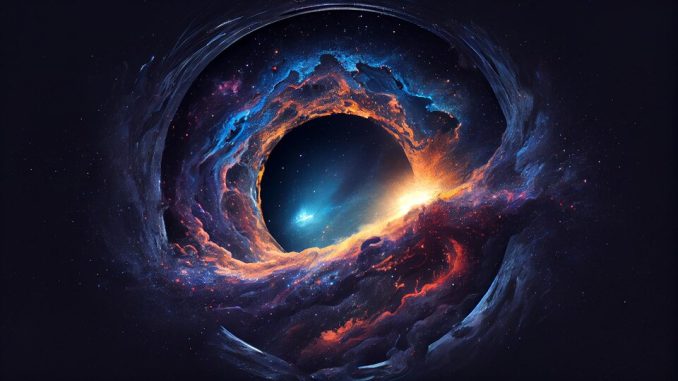
Black holes and gravitational waves are two of the most fascinating and puzzling phenomena in the universe. Black holes, cosmic phenomena with gravitational forces so strong that even light can’t escape, have long fascinated humans. Astronomy has entered a new age with the prediction and discovery of gravitational waves and spacetime ripples created by the most intense events in the universe. This fascinating essay explores the cosmic mysteries revealed by black holes and gravitational waves and how they change our knowledge of the cosmos.
Black Holes: The Cosmic Enigma:
Black holes are some of the most mysterious and awe-inspiring phenomena in the universe. Massive stars’ deaths create these cosmic mysteries. Gravity collapses a star once its nuclear fuel runs out. One sector of space exists where gravity is so strong that even light cannot escape. A black hole’s event horizon defines its boundaries.
Understanding black hole structure and behaviour is a crucial science. It explores the foundations of astrophysics and spacetime. Black holes range from stellar-mass black holes produced by enormous stars to supermassive black holes that anchor galaxies. Their mass, spin, and electric charge define them. Black holes display intriguing activity, including accretion disks, strong particle jets, and merging black holes.
Black holes have a significant influence on the cosmos. These cosmic giants shape galaxies and star destinies. They are crucial to quasars and gamma-ray bursts. Black holes help us comprehend dark matter and dark energy, the unexplained components of the cosmos. Black holes are mysterious phenomena that may reveal a lot about the universe they inhabit.
Gravitational Waves: A New Cosmic Messenger:
In 1915, Albert Einstein predicted gravitational waves, revolutionizing the hunt for cosmic mysteries. According to his general relativity theory, massive objects may bend spacetime and cause gravitational waves. These waves reveal large objects’ motion and interaction in the cosmos. Gravitational waves are very feeble by the time they reach Earth, making detection difficult.
The LIGO and Virgo collaboration revolutionized gravitational wave astronomy in 2015. Gravitational waves created tiny spacetime distortions, which these observatories detected using laser interferometry. LIGO discovered gravitational waves from two massive black holes colliding in September of that year. Astrophysics changed when scientists could “hear” the cosmos as well as see it.
Gravitational waves come from many cosmic sources. Black hole mergers, neutron star collisions, pulsar vibrations, and even the Big Bang may cause them. Each source offers distinct opportunities to study the cosmos. Gravitational waves provide a new tool to explore the universe, complementing conventional astronomy.
The Marriage Of Black Holes And Gravitational Waves:
Black hole mergers were crucial to the marriage of black holes and gravitational waves. It was anticipated theoretically, but its discovery offered new avenues of research. Black hole mergers release gravitational waves due to their ceaseless dance. These waves reveal the merging of black holes’ masses, spins, and trajectories, helping scientists understand this cosmic dance.
Combining gravitational wave astronomy with classical astronomy is significant. Like a symphony, gravitational wave detections let scientists “hear” the universe’s most intense events. Beyond black hole mergers, this symphony includes neutron star spins and heavy element collisions. Especially merging black holes reveal the spread and population of these fascinating cosmic phenomena.
Even while much has been revealed, black holes remain mysterious. Many uncertainties remain about their creation, function in galaxies, and possible relationship to dark matter. The continuous union of black holes and gravitational waves provides a growing treasure trove of cosmic knowledge.
Cosmic Implications: Black Holes And The Universe:
There’s more to black hole research than curiosity. Black holes shape galaxies and help us comprehend dark matter and dark energy. Understanding galaxy evolution requires understanding supermassive black hole development and activity at the cores of galaxies. These massive black holes may influence galaxies by affecting star distribution and the creation of bulges and bars.
Quasars, the brilliant, active nuclei of galaxies where supermassive black holes feed on matter, are also closely related. These quasar systems reveal the complex relationship between black holes and galaxies. Supermassive black holes are linked to dark matter and dark energy, two of the biggest cosmic mysteries. Dark matter pulls galaxies and clusters together, while dark energy accelerates the cosmos.
The Future Of Gravitational Wave Astronomy
Black holes and gravitational waves have ushered in a new era of astronomy, but this is only the beginning. Gravitational wave astronomy will provide further discoveries. The worldwide network of gravitational wave detectors will grow, improving our capacity to detect and investigate cosmic ripples.
The European Space Agency’s Laser Interferometer Space Antenna (LISA) space observatory is highly awaited. LISA detects low-frequency gravitational waves from an array of cosmic events, including substantial black holes in galaxy cores spiralling. This observatory will be added to LIGO and Virgo to provide a more comprehensive gravitational wave spectrum.
Other expeditions and observatories will explore gravitational waves’ cosmic mysteries. The Einstein Telescope, a 3rd-gen gravitational wave observatory, and the Cosmic Explorer, which intends to improve ground-based detector sensitivity, are examples. These missions will examine the cosmos in unprecedented detail, perhaps revolutionizing gravitational wave astronomy.
Conclusion
Black holes and gravitational waves are essential threads in the cosmic fabric. Black hole mergers and the celestial symphony of gravitational waves have yielded impressive findings. This partnership has helped us grasp these cosmic giants’ complicated dance and its effects on the cosmos.
The connection between black holes and gravitational waves evolves as we go across the universe, revealing dark matter, dark energy, and galaxy structure. Expanded detector networks and ambitious missions promise a bright future for gravitational wave astronomy. These advances promise to reshape our knowledge of the universe, paving the way for future discoveries.






Leave a Reply